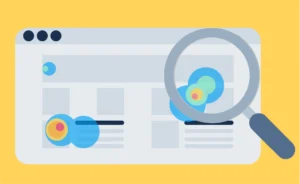The Power of Heatmaps: Understand Your Visitors’ Behavior
Bridging the Gap: See How Visitors Interact
You know the ideal behavior of your website visitor. You want them to click to buy now, try now, download, or contact. But what happens when they don’t have ideal behavior? What the heck are they doing?
Website heatmaps have become essential for businesses to understand how their visitors interact with their online presence. Are your calls to action really driving the results you expect? While traditional analytics can tell you how many people visit your site and how long they stay, they often fail to capture the nuances between arrival and conversion. Heatmaps provide a visual of user behavior, offering a more detailed view of where your design and calls to action succeed—and where they fall short.
 Heatmaps work by tracking user interactions across different parts of a webpage or app. This data is then layered over the site in a color-coded format. Heatmaps provide a visual and intuitive way to understand user behavior. Business owners can easily see which website sections attract attention and which get overlooked. This allows for smarter, more targeted adjustments, closing the gap between what your site asks users to do and what they are doing.
Heatmaps work by tracking user interactions across different parts of a webpage or app. This data is then layered over the site in a color-coded format. Heatmaps provide a visual and intuitive way to understand user behavior. Business owners can easily see which website sections attract attention and which get overlooked. This allows for smarter, more targeted adjustments, closing the gap between what your site asks users to do and what they are doing.
For example, if users are consistently clicking on a non-clickable image or scrolling past a critical call-to-action button, it suggests a disconnect between the website’s design and user expectations. Heatmaps can reveal these pain points in ways that are not immediately obvious through traditional analytics. Rather than guessing why certain pages underperform, business owners can see exactly how users are engaging, or failing to engage, and make data-driven decisions to improve the layout, relieving the stress of uncertainty.
Heatmaps in Action: Identify Pain Points and Opportunities
Optimizing Calls to Action
Calls to action are particularly ripe for optimization through heatmap analysis. Whether you are asking visitors to make a purchase, sign up for a newsletter, or contact you, the placement and design of these elements can make or break your conversion rate. Heatmaps can show whether a call to action is in a spot where users are most likely to click or if it is hidden in a part of the page that is getting little attention. For businesses, this data is invaluable.
Content Presentation: Engage Users Effectively
Heatmaps also offer insights into content presentation. If you run an e-commerce site or publish long-form content, knowing how far down the page users scroll or where they linger can inform how you structure your material. For instance, if a heatmap shows that users stop scrolling before reaching key product details, this is a sign that important information needs to be moved up. In the same way, calls to action that appear too late in the page may be missing their audience entirely. Small adjustments based on heatmap data can lead to significant improvements in user engagement and conversions.
Mobile Optimization: Win on Smaller Screens
Mobile optimization is another area where heatmaps prove their worth. With mobile traffic on the rise, ensuring that your site performs well on smaller screens is essential. A heatmap can reveal whether mobile users are interacting with the site differently than desktop users, which might suggest the need for design adjustments specific to mobile. Mobile users, for instance, may scroll faster and click less, requiring more prominent calls to action and simplified navigation.
Data-Driven Decisions: Take Action with Heatmap Insights
Continuous Improvement: Monitor and Adapt
Once insights from heatmaps are gathered, the next step is to take action. Businesses can begin by fine-tuning elements such as calls to action, content flow, and overall layout based on the areas that receive the most user attention. The data-driven nature of these changes means they are far more likely to succeed than purely instinctual design choices. Over time, the continuous monitoring of heatmap data can help business owners stay attuned to shifting user preferences and emerging trends, ensuring that their websites remain optimized and effective.
Conclusion: Close the Gap, Boost Results
Heatmaps offer a way to bridge the gap between what you want your visitors to do and what they are actually doing. By providing a visual representation of user engagement, they help business owners pinpoint areas of friction, refine their calls to action, and improve the overall user experience. Whether you are seeking higher conversion rates, better mobile performance, or simply a more intuitive site design, heatmaps give you the insight you need to make informed decisions. By closing this gap, businesses can ensure that their websites not only attract visitors but also guide them seamlessly toward desired actions.
Maximize Your Website’s Performance: Free Heatmapping Integration
Unlock the full potential of your website with free heatmapping integration—exclusively available through the end of the year! Discover exactly how your visitors are interacting with your site, optimize for better engagement, and drive more conversions. Don’t miss out on this limited-time offer—schedule your free consultation today!
